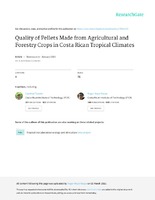Quality of pellets made from agricultural and forestry crops in costa rican tropical climates
Date
2015Author
Valaert, Jorre
Tenorio-Monge, Carolina
Moya-Roque, Róger
Tomazello-Filho, Mario
Metadata
Show full item recordAbstract
Pellets may be produced with different types of agriculture or forestry crops in Costa Rica. This work evaluated the energy, physical, and mechanical properties of pellets fabricated from 12 types of agricultural and forestry crops (Ananas cumosos, Arundo donax, Coffea arabica, Cupressus lusitanica, empty fruit bunch and oil palm mesocarp fiber of the fruit of Elaeis guineensis, Gynerium sagittatum, Pennisetum purpureum, Phyllostachys aurea, Saccharum officinarum, Sorghum bicolor, and Tectona grandis), and similarities among these crops were established by multivariate principal component analysis. High variation was found in the pellet properties. The energy evaluation revealed that C. lusitanica and P. aurea are the crops with the best qualities for fuel use because of their high calorific values (from 16807 kJ/kg and 19919 kJ/kg, respectively) and low ash content (1.03% and 3.39%, respectively). As for physical properties, most crops exhibited values within the range noted by several authors and standards. All 12 pellet crops displayed high durability (from 72.12% to 92.98%) and compression force (from 295.18 N to 691.86 N). Moreover, the evaluation of crop similarities allowed the determination of four group combinations. Within these groups, C. lusitanica, P. aurea, and G. sagittatum had similar energy qualities and the best caloric characteristics.
Source
Tenorio, C., Moya, R., Tomazello, M. & Valaert, J. (2015). Quality of Pellets Made from Agricultural and Forestry Crops in Costa Rican Tropical Climates. Bioresources, 10(1), 482-498. Recuperado de https://ojs.cnr.ncsu.edu/index.php/BioRes/article/view/BioRes_10_1_482_Tenorio_Pellets_Costa_Rican_Crops/3220Share
Metrics
Collections
- Artículos [37]
The following license files are associated with this item:



